#cholita bowler hat
Explore tagged Tumblr posts
Text


Picture of a Bolivian woman in Andean fashion and an unknown art piece potraying a Bolivian woman.
#Andean women#so beautiful#Andean region#bolivian indigenous#cholita bowler hat#Andean fashion#Andean tumblr#Bolivia#Andean indigenous#Art depicting andean indigenous people#ndn tumblr#native south american#native women in art
21 notes
·
View notes
Photo

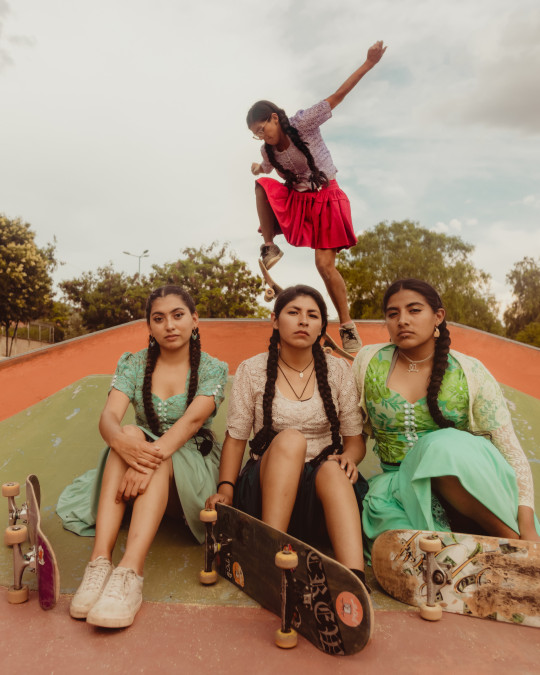
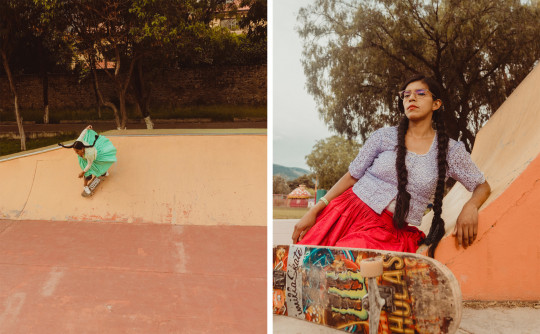
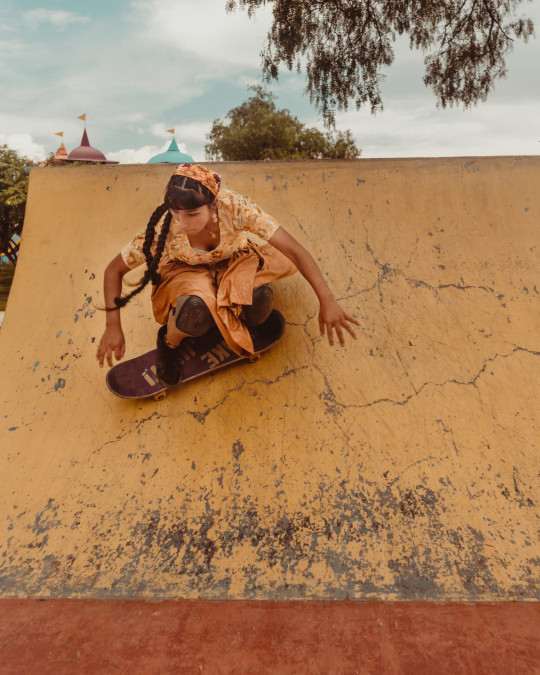

- Celia D. Luna, “Cholitas Skaters” (2023)
Bolivia’s Indigenous Quechua and Aymara women, known derogatorily as “cholitas,” were marginalized and ostracized from society. Distinguished by their long braids, wide skirts, and bowler hats—an amalgamation of styles resulting from Spanish colonizers forcing Indigenous people to adopt European styles during the Inquisition—the style evolved into a symbol-rich, empowered look.
#chromatic voice#we all make art#celia d luna#quechua#aymara#indigenous people#indigenous women#usermarmalade
885 notes
·
View notes
Photo
Cholitas: Indigenous Aymara women mountaineers in Bolivia
Located within the Sajama National Park in Bolivia's Oruro Department and part of the western volcanic mountains in the Andes Mountains near the Chilean border, Mount Sajama is of interest to indigenous Aymara female mountaineers
Les cholas (cholitas) de Bolivie - Bolivia Excepcion
“Cholita” is a diminutive form of the word “chola,” originally a pejorative term referring to those of indigenous heritage. In Bolivia, the most populous group of indigenous people are the Aymaras, who have their own language and distinctive style of dress.
The mythical cholitas are a strong symbol of Bolivia. In the familiar Spanish, “cholita” means simply a young Bolivian woman. It usually refers to someone who self-identifies as a member of an indigenous culture.
The iconic bowler hat, the long black braids, the adjusted corset, and the brightly colored puffed skirt: their outfit is well known all around the world. The mythical cholitas are a strong symbol of Bolivia. Yet for decades, they have suffered an important racial and social discrimination.
Cholitas have suffered a long history of racial and social discrimination. Forced into servitude under colonial rule and later relegated to the margins of society, Bolivia's many indigenous peoples were long excluded from mainstream society






120 notes
·
View notes
Text
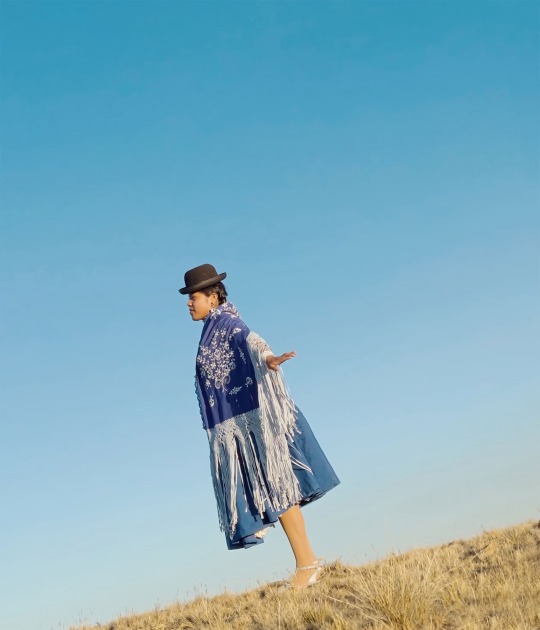
Noelia, a 19-year-old wrestler, poses for a photograph in her traditional cholita garb. Photograph By Luisa Dörr
Meet The Women Wrestling Their Way To Equality in the High Andes
Bolivia's stylish Flying Cholitas have merged modern wrestling with their community's history of activism.
— By Laurence Butet-Roch | Photographs By Luisa Dörr | August 30, 2018
“People need heroes, wrestlers, champions of their own who can be admired,” reflects Brazilian photographer Luisa Dörr, who spent ten days in El Alto, Bolivia, with a unique group of female wrestlers known as the Flying Cholitas. Recognizable by their colorful and elegant attire of multilayered skirts, embroidered shawls, and precarious bowler hats, cholitas emerged at the turn of the millennium—an expression of the indigenous renaissance taking hold in the Americas.

Angela, a single mother who uses her wrestling money to pay for her son's education, says, "People need some reason to fight, and mine is my son." Her 12-year-old son comes to watch all of her matches.
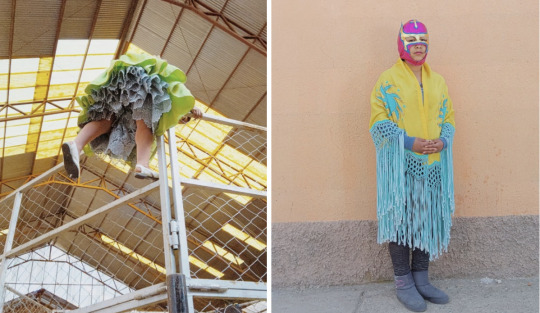
Left: Once a year in El Alto, Bolivia, wrestlers take part in a large-scale mixed-gender fight. Anyone wishing to escape the fight must jump the fence around the ring, and the last person inside is the winner. Right: Wara, a 19-year-old wrestler, says, "Thanks to wrestling, I have traveled to many places in Bolivia. For us, this is our profession."
Dörr, who likens them to Hollywood superheroes capable of flying, first encountered the wrestlers while her husband was working with local architect Freddy Mamani. She recalls attending Sunday matches at the community’s multifunctional center: “It's been a long time since I stopped liking the men's fights. They're the same as ever, but the Cholitas are the ones that save the show. The younger audience members identify with the good heroines, while the older ones prefer the rougher ones,” she says.
The Cholitas train twice a week and watch YouTube videos of Lucha Mexicana to improve their techniques and tricks. “The fight, more than anything, is a constant update of maneuvers. It's like riding a bicycle; if you learn to walk, you never forget. But if you want do tricks, you need to practice. The fight is the same. An eternal learning," explains Claudina, whose father, brother, and sister also wrestle.
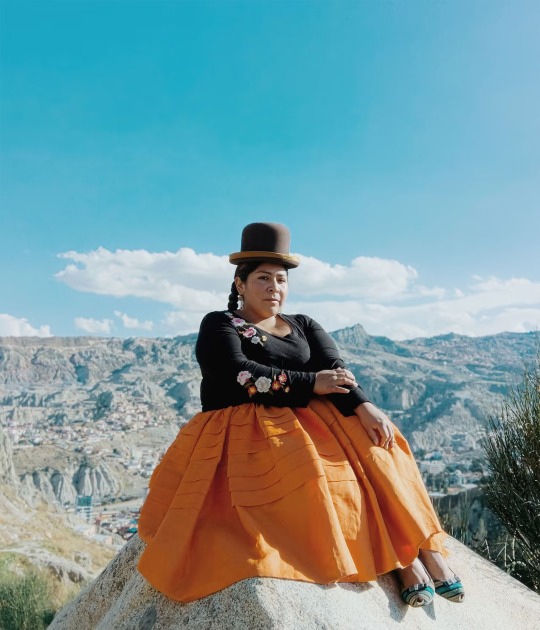
Claudina, a Flying Cholita, comes from a family of wrestlers. She says, "My father was a fighter. My brother is a fighter. My sister is a fighter. I am a fighter."
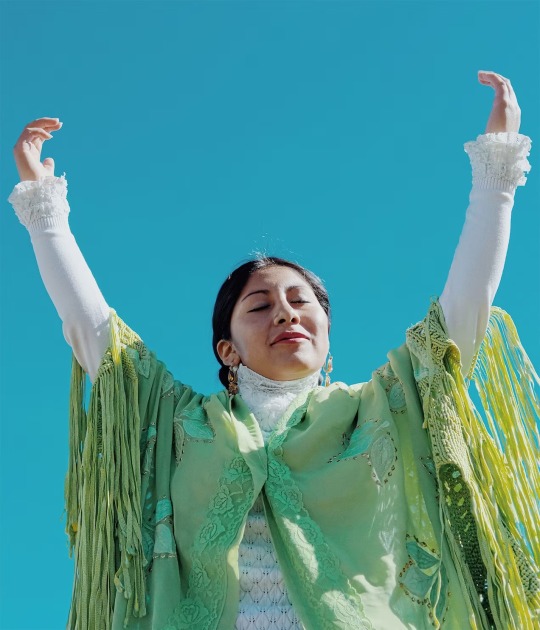
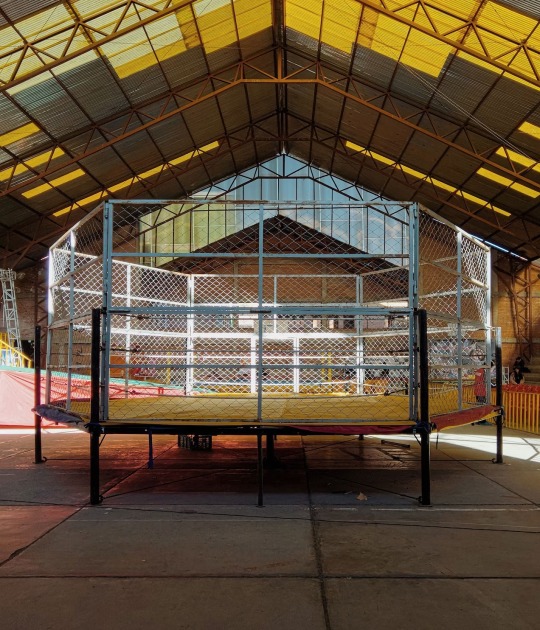
Left: Wara, 19, raises her hands in the air as her portrait is taken. Right: The ring at the Dolores de El Alto Sports Center is surrounded by a fence—and, during matches, by cheering, shouting, and jeering fans.
And the better they get, the more they can assert their presence in a field dominated by men. At times, both genders are even pinned against one another. "When a woman fights 100 percent, men want to fight 1,000 percent. They do not accept that they are overcome. In our companions, there are also some anti-Cholas,” says Mary Llanos Saenz, known as Juanita La Cariñosa in the ring, who’s been fighting for almost 20 years. “In the beginning, we were not allowed to enter the men's room. We used to change in the stands and wait outside. That's why we created the Association of Fighting Cholitas. There, men do not get involved.”
Monica, a friend and social worker in the community, was Dörr’s way in. “[The Cholitas] don’t really care about journalists and fancy magazines,” Dörr remarks. “Many of them were not interested with wasting time with a photographer on a story they will not ever read.” Their attitude toward media is at least partly fueled by the fact that the cholitas have much more urgent concerns than becoming famous. For centuries, they’ve also been fighting outside the ring to protect the well-being of their community.
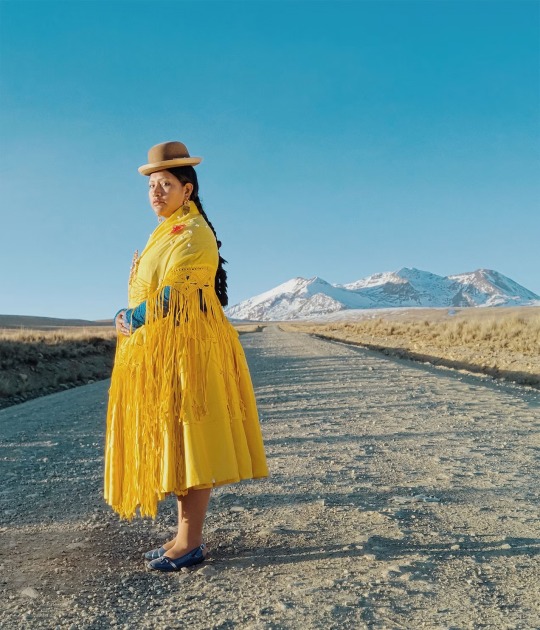
Angela, like many Flying Cholitas, is a single mother. Others have partners who are also wrestlers.
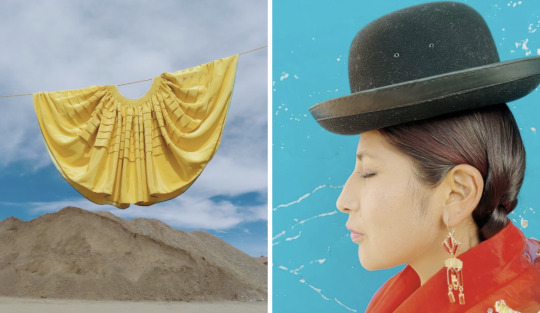
Left: The voluminous skirts women in Bolivia were forced to wear by Spanish settlers for centuries are now symbols of identity and pride. Right: Sonia, who owns a beauty salon, says, "Sometimes we get hurt and we have to stop [fighting] for a few months. I already broke my wrist, but I never had any injuries that would impede me [from fighting or working] again."
Most cholita wrestlers are Aymara, an indigenous nation residing in the high plains of South America. The group has faced ethnic oppression and exploitation since the Spanish colonization of the region. Referred to pejoratively as “cholo” or “chola” at the time, they were forced to perform menial tasks for aristocrats; required to adopt European customs; refused entry to restaurants, public transportation, and certain wealthy neighborhoods; and denied the opportunity to vote, own land, and learn to read.
Resilient, the community organized, leading several successful movements over many decades, the latest of which was the ousting of President Gonzalo Sanchez de Lozada—currently facing charges for extrajudicial killings—and the election of an Aymara politician, Evo Morales, to the country’s highest office. In the process, they’ve reclaimed the once-pejorative name and style of dress, turning both into symbols of pride.
“When El Alto gets angry with the state, because they have neglected their schools, their health centers, or their markets, or because of the absence of security in the neighborhoods, it is the women who go out and demonstrate,” explains Dörr. “And therein lies the essence, the reason why people enjoy watching and admiring the Cholitas fight, because it is the dramatization of the Chola Aymara woman from El Alto.”
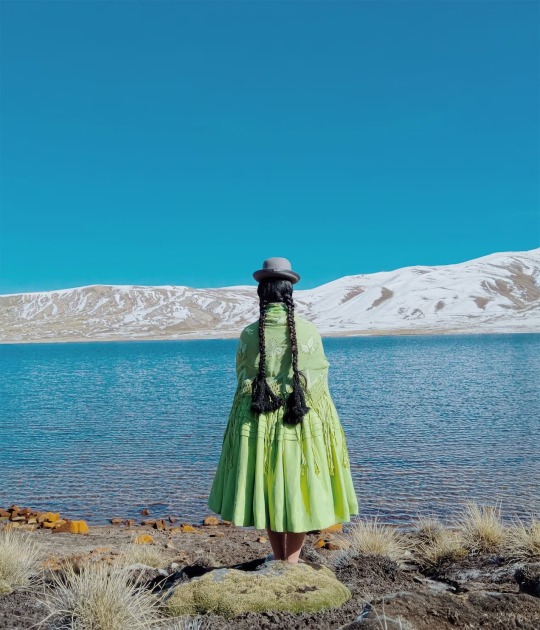
When many members of Bolivia's indigenous community were forced to work as servants for Spanish occupiers, they were made to wear a particular set of garments. Some of these items, including voluminous skirts and bowler hats, are now symbols of pride for cholitas.
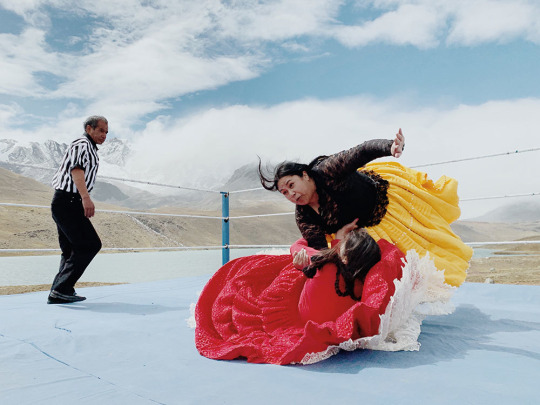
— Luisa Dörr is a Brazilian photographer based in Bahia, Brazil.
1 note
·
View note
Text
Why do Cholitas wear bowler hats?
Why do Cholitas wear bowler hats? on http://www.my-bolivia.com/why-do-cholitas-wear-bowler-hats/
Why do Cholitas wear bowler hats?


Why do Cholitas wear bowler hats?
View Reddit by Meduxnekeag – View Source
0 notes
Text
BOLIVIAN PAPER DOLLS/COLORING SHEETS
**Due to COVID-19, I am giving these coloring sheets/paper dolls for FREE to download. You can also email me if you want a copy ([email protected]).
BOLIVIAN PAPER DOLL SERIES:Free to download for personal use. ©
This paper doll represents the department of Santa Cruz
youtube
Santa Cruz de la Sierra is the 14th fastest growing metropolis in the world, and home to more than 3 million people in a country with a population of 11 million. The city of Santa Cruz has become the nation’s economic powerhouse and one of South America’s most successful and sustainable towns.
Santa Cruz Doll
Santa Cruz Color
youtube
The Afro-Bolivian community reside in the Yungas region of Bolivia. “𝐀𝐟𝐫𝐨𝐛𝐨𝐥𝐢𝐯𝐢𝐚𝐧𝐚” and “𝐀𝐟𝐫𝐨𝐛𝐨𝐥𝐢𝐯𝐢𝐚𝐧𝐨” is a term used by people of Bolivian nationality with African roots. It is apparent in the dances and music what an impact and contribution they have given to Bolivia as a whole.
YUNGAS DOLL
YUNGAS DOLL COLOR
Cochabamba, Bolivia
youtube
Inhabited for over a thousand years, the department of Cochabamba is one of Bolivia’s most understated regions. Cochabamba has beautiful year-round weather, stunning nature reserves, and ancient archaeological sites. It is also known as the gastronomical capital, and heart of Bolivia.
COCHABAMBA DOLL DOWNLOAD
COCHABAMBA COLOR DOLL DOWNLOAD
Chuquisaca, Bolivia
youtube
Chuquisaca is located in the south of Bolivia. The region is rich in culture and history. Sucre (the capital of Chuquisaca) is Bolivias' first capital. Known as the city of four names (Charcas, La Plata, Chuquisaca, and Sucre) in 1991 UNESCO designated it a world heritage site to protect its many pristine and historical significance.
CHUQUISACA DOLL
CHUQUISACA DOLL COLOR
Tarija, Bolivia
Tarija lies to the south of Bolivia and borders Argentina and Paraguay. It is known as Bolivias premier grape growing region, with a mediterranean climate, it is the ideal location for wine production. Its got small town charm and a laid-back atmosphere. It is known as “The Capital of Smiles”.
TARIJA DOLL DOWNLOAD
TARIJA DOLL DOWNLOAD COLOR
Pando, Bolivia
youtube
Pando: The most northern part of Bolivia is covered with lush forests, biodiversity, and with abundant flora and fauna that characterize this Amazonian region. It is situated between Peru and Brazil, whose history makes it the youngest department to Bolivia. It was founded officially at the beginning of the 20th century from what was left of the Acre Territory, lost to Brazil as a result of the Acre War (1903). At the end of the Acre war, Bolivia was left with less than 10% of its original territory.
PANDO DOLL DOWNLOAD
PANDO COLOR DOWNLOAD
Oruro, Bolivia
youtube
Oruro attracts numerous tourists to its “Carnaval de Oruro”, considered one of the great folkloric events in South America for its masked “Diablada”. In 2001 it was named apart of Bolivias Intangible Cultural Heritage of Humanity by UNESCO.
ORURO DOLL DOWNLOAD
!NEW! ORURO DOLL COLOR DOWNLOAD
La Paz, Bolivia
youtube
LA PAZ : Situated on the Altiplano at the western border of Bolivia is the department of La Paz, a spectacular area enveloped by a wide variety of landscapes and attractions. Home to the mighty mountains, sub tropical valleys, and ancient architectural sights.
..........................................
About the paper doll: La Paz is home to the iconic Cholita. The dress of the Cholita originates centuries ago during the period of Spanish colonization. In an effort to assimilate their new subjects into Spanish culture they required the native inhabitants to dress in peasant attire common to Spain at the time. The natives have since adopted this wardrobe, reclaiming and taking the narrative away from what it once was, they have now made the pollera(skirt) and bowler hat distinctively Andean.
Dance Caporales: I took a poll, and the dance that won for the department of La Paz was Caporales. Caporales were created and presented to the public for the first time in 1969 by the Estrada Pacheco brothers, who were inspired in the character of the 'Caporal' this is the overseer of slaves and was usually mixed race, wore boots and held a whip, a dance that belongs to the region of the Yungas Bolivia. Although Yungas is a part of the La Paz Department and because of their significant contribution I will be adding a Yungas paper doll with the help of @karinanogales @africanbolivianwomen.
Music:Los Kjarkas (Saya Caporal)
LA PAZ DOLL DOWLOAD
!NEW! LA PAZ DOLL COLOR DOWNLOAD
Potosí, Bolivia
youtube
Tucked away in the southwest of Bolivia is the department of Potosí. Regarded for its captivating history, ancient sights, stunning scenery, Potosí’s most sought after attraction is Salar de Uyuni; the largest salt flat in the world.
Music: Waritas De Bolivia
POTOSÍ DOLL DOWNLOAD HERE
Beni, Bolivia
youtube
Beni is located to the northeast of Bolivia, in the tropical lowlands. It borders Brazil and is home to a record-breaking number of animal and plant species. One of the wettest regions in Bolivia, Beni is almost completely covered in pampas and jungle. Along with its stunning flora and fauna, Beni is also a great place to learn about the many indigenous cultures that inhabit the region.
BENI DOLL DOWNLOAD HERE
Download Bilingual Coloring Sheets here:
Saya AfroBoliviana
Tipoy Sheet
Kusillo Sheet
China Supay Sheet

#charlene eckels#bolivian#american#artist#bolivian american artist#bolivian american art#MOLAA#museumoflatinamericanart#NMWA#nationalmuseumofwomeninthearts
1 note
·
View note
Text
Blinder Passagier
19.06.2019
Am Titicacasee treffen wir uns mit der Deutschen Thea, die wir schon vor einigen Wochen in Chile kennengelernt haben. Der 3840 Meter hoch gelegene, riesige See gilt als höchster schiffbarer Binnensee der Welt, deren Ufer sich Peru und Bolivien teilen. Wir erkunden ausschließlich die bolivianische Seite und starten in der touristischen Stadt Copacabana. Unser schönes Hostel verfügt über einen eigenen Garten mit tollem Blick auf die Bucht, in dem drei ausgewachsene Alpakas und ein braunes Baby-Alpaka gehalten werden. Wenn das Baby frisst, lässt es sich sogar streicheln und es fühlt sich wie ein flauschiges Kuscheltier an. Wir verlieben uns auf der Stelle in das niedliche Tier. Nach den Städten genießen wir die Ruhe und die gute Landluft. Wir wandern am Seeufer entlang und erkunden die umliegenden Dörfer. Abends kehren wir in unser hosteleigenes Restaurant ein und essen Lasagne und leckeres Käsefondue. Der entspannte Rhythmus fühlt sich wie ein erholsamer Kurzurlaub an.
Mit dem Schiff steuern wir die Insel Isla del Sol an, von der wir leider nur wenig sehen können, da in Folge eines Konflikts zwischen den Gemeinden der Großteil der Insel für den Tourismus gesperrt wurde. Auf der bergigen Insel geht sehr gemächlich zu. Es gibt keine Autos, so dass die Insel nur über schmale Pfade begehbar ist. Als wir mit dem Boot ankommen, ahnen wir nicht, wie weit oben unsere Unterkunft liegt, so dass wir bei der Höhe und mit unserem schweren Gepäck schnell außer Atem kommen. Kaum zu glauben, dass die vielen alten Inselbewohner diese schweren Wege jeden Tag nutzen. Oben angekommen, werden wir mit einem wunderschönem Seeblick belohnt. Unser Reisefreund Jannis stößt bald zu uns und bezieht das vierte Bett in unserem Zimmer. Abends essen wir in einem gemütlichen Restaurant, wo es nur Kerzenlicht gibt. Der freundliche Besitzer schmeißt den Laden ganz allein und kocht schmackhaftes Essen. Während wir lange auf unsere Gerichte warten, spielen wir UNO mit einigen Sonderregeln, wovon wir die nächsten Tage nicht genug bekommen.
Eine ganz besondere Zeit verbringen wir auf der winzigen und wenig besuchten Isla de la Luna. Hier leben nur 27 Familien mit Solarenergie und Trinkwasser, dass aus Regenwasser gewonnen wird. Es gibt kein Lebensmittelgeschäft, sondern nur ein paar Häuser, eine kleine Kirche und einen Fußballplatz. Wir nächtigen in einer sehr einfachen Familienpension. Edwin und seine Familie sind unfassbar freundlich und erfüllen uns jeden Wunsch. Wir umrunden die Insel auf dem steinigen Strand und betrachten die fernen schneebedeckten Berggiganten, die den See umgeben.
Die Schönheit des Sees ist aber auch trügerisch, da hier die Umwelt massiv zerstört wird. Zwar scheint der klare See auf den ersten Blick sauber, doch in Wahrheit verschmutzen giftige Minenabwässer das Wasser. Einheimische erzählen uns, dass sie kaum noch Fische fangen und die traditionellen Strohinseln, auf denen Menschen früher in unmittelbarer Nähe zum Seeufer lebten, gibt es aufgrund des verschmutzen Wassers auch nicht mehr. Anwohner klagen zunehmend über gesundheitliche Probleme. Daneben fließen Teile des Abwassers aus der Millionenstadt El Alto und den am See gelegenen Orten ungefiltert in den See, da es hier noch keine Kläranlage gibt. Durch den Klimawandel ist der See im Vergleich zu 2003 bereits um über 15 Prozent geschrumpft. Der Wasserspiegel liegt mittlerweile 25 Meter unter dem normalen Niveau, da es zu wenig regnet, die Bäche von den Gletschern versiegen und durch die stärkere Sonneneinstrahlung Seewasser verdunstet. Eine Studie der Vereinten Nationen prognostiziert, dass der See irgendwann in drei Seen zerfallen könnte, da einige Stellen nicht so tief sind.
Die Stadt La Paz geht fließend in die Metropole El Alto über, die sich über den Kessel bis weit in die Hochebene erstreckt. Hier tauchen wir in das impulsive Stadtleben ein. Verlässt man die zentralen Straßenzüge Richtung El Alto, gelangt man in ein Labyrinth von bunten Straßenmärkten. Hier verkaufen meist ältere Frauen, die Cholitas, Fleisch, Gemüse, Obst, Brot, Nüsse und Gewürze. Sie tragen zwei geflochtene Zöpfe und die typischen, ursprünglich für Männer gedachten, Bowler-Hüte. Durch die vielen Lagen an Kleidung wirken sie übergewichtig. Gerne zeigen sie ihre straffen, kräftigen Waden, da diese in Bolivien als Schönheitsideal gelten.
Wir fragen uns, warum in manchen Läden tote Lama-Föten verkauft werden. Der indigene Aberglaube spielt eine wichtige Rolle im alltäglichen Leben der Menschen. So wird in jedem Wohnhaus ein Lama-Fötus eingemauert, um die Pachamama (Mutter Erde) zu besänftigen und das Haus vor Gefahren zu beschützen. In besonders großen Gebäuden, wie Hochhäuser, kam es in der Vergangenheit vor, dass obdachlose Menschen lebend eingemauert wurden, da Pachamama in diesem Fall ein größeres Opfer benötigt. Wir lesen von illegalen Elefantenhäusern, in denen verarmte, verzweifelte und hoffnungslose Menschen eine Matratze, einen Eimer und billigen Fusel für wenig Geld bekommen, um sich zu Tode zu saufen. Die Elefantenhäuser stehen im Verdacht noch lebende Menschen als Opfergabe zu verkaufen.
Um den chaotischen Verkehr in der Stadt zu entlasten, wurde in den letzten Jahren das größte und modernste Seilbahnnetz der Welt mit Hilfe von deutschen und österreichischen Firmen gebaut. In einer Stadt mit Kessellage, wo zum Teil enorme Höhenunterschiede bewältigt werden müssen, macht diese Art des Transports durchaus Sinn. Die moderne Seilbahn steht im krassen Kontrast zu den quirligen Armenvierteln, über denen die Wagen leise schweben. Auch wir betrachten die Stadt aus dieser Perspektive in der Abenddämmerung. Franz und Jannis wechseln das Transportmittel, um mit dem Mountainbike die Death Road zu befahren, die bis 2007 als gefährlichste Straße der Welt galt. Schätzungen zufolge starben jährlich 200-300 Menschen auf der unbefestigten Serpentinenstraße, die von 4670 auf 1200 Meter abfällt und dabei fast alle Klimazonen Südamerikas durchquert. Heute nutzen fast nur noch Touristen die Straße. Franz und Jannis verfallen dem Geschwindigkeitsrausch und haben viel Spaß dabei, die Straße kontrolliert herunterzurasen und dabei durch kleine Wasserfälle und Flüsse zu fahren.
El Alto wächst unaufhaltsam, da viele Menschen ihre Bergdörfer verlassen in der Hoffnung auf ein besseres Leben in der Stadt. Oftmals werden die neuen Bewohner enttäuscht und leben in extremer Armut. Bolivien ist eines der Länder, das vom Klimawandel am stärksten betroffen ist. Das Leben in den Bergen war für die Menschen schon immer hart und entbehrungsreich. Doch durch die zunehmenden unberechenbaren Wetterextreme wird es immer schwerer, in den Bergen zu überleben, weshalb die Bergbevölkerung als Klimaflüchtlinge ihre Heimat verlassen müssen.
Eigentlich ist es purer Wahnsinn, dass auf einer Höhe von über 4000 Meter wachsende Millionenstädte wie La Paz und El Alto überhaupt existieren. Der Wassermangel ist schon jetzt ein riesiges Problem, da sich die Wasserreservoirs in Form von Gletscherseen durch den Klimawandel dramatisch verkleinern und die Minen das Wasser vergiften. Große Teile von El Alto konnten zeitweise nur mit Hilfe von Tankwagen mit Wasser versorgt werden. Die Bewohner sind daher dazu gezwungen, Wasser sehr sparsam zu nutzen und Regenwasser in großen Tanks zu sammeln.
Auf dieser Höhe wächst natürlich kaum Obst oder Gemüse, weshalb alles aus dem Tiefland hier hergebracht werden muss. Der Präsident hat persönlich die Abholzung großer Teile des Amazonas angeordnet, damit neue Flächen für die Landwirtschaft entstehen können. Der bolivianische Amazonas ist daher einer der am schnellsten schrumpfenden Dschungel auf der Welt. Eine starke Umweltbehörde gibt es nicht im Land und ausländische NGOs werden bewusst kleingehalten. Was zählt, ist einzig und allein der wirtschaftliche Fortschritt etwa in Form von großen Infrastrukturprojekten.
Von La Paz fahren wir langsam mit dem Bus ins Tiefland. Einmal fährt im Laderaum des Busses ein armes Schaf als blinder Passagier mit, so dass unsere Rucksäcke danach nach Tier riechen. In Cochabamba und Santa Cruz zeigt Bolivien ein ganz anderes Gesicht. Die Städte sind moderner, geordneter und Weiße sowie Mestizen bestimmen das Stadtbild. Bevor wir nach Brasilien reisen, verbringen wir im heißen Santa Cruz viel Zeit in unserem gemütlichen Apartment mit Netflixzugang und genießen die sehr gute Restaurant- sowie Cafészene. Wir erleben einen schönen Geburtstag von Julia. Am morgen bereitet Franz ihr einen mit Blüten dekorierten Geburtstags- und Frühstückstisch vor. Julia möchte zu ihrem Ehrentag gerne ein wildes Faultier sehen. Im Wald entdecken wir tatsächlich zwei Tiere in den Bäumen und bestaunen auf dem Weg riesige Schmetterlinge.

Garten vom Hostel

Alpaka-Baby

Fütterung



Die Ahnen werben für Coca Cola

Mit Thea auf der Isla del Sol




Isla de la Luna

Julia mit Thea und Jannis

Unser sympathischer Bayer Jannis

Blick auf La Paz und El Alto


Seilbahn in El Alto

Death Road

Nach dem Geschwindigkeitsrausch mit Jannis


Im tropischen Santa Cruz

1 note
·
View note
Text
The rise of Bolivia’s indigenous 'cholitas'
As recently as 10 years ago, Bolivia’s indigenous Aymara and Quechua women were socially ostracised and systematically marginalised. Known as ‘cholitas’, these women, recognisable by their wide skirts, braided hair and bowler hats, were banned from using public transport and entering certain public spaces. Their career opportunities were severely limited. While these women have been organising and advocating their civil rights since at least the 1960s, their movement was invigorated by Evo Morales’ election as Bolivia’s first indigenous president in 2006.
In Cholita’s Rise, the photographer Eduardo Leal has created an exhibition of work that portrays their accomplishments and celebrates their success while also looking to inspire others.
Some of my favourites from the article below:

Yolanda Mamani Mamani, 30, at Deseo radio station in La Paz. A feminist activist, she started to work when she was nine, first as a babysitter and then as a cleaner. She wished to study but says her bosses never gave her a chance to. At 18, she became part of the Cleaners Association and started a partnership with the feminist association Mujeres Creando, where became the producer of a radio show in defence of the rights and against the abuses and discrimination of the cleaners of Bolivia

Bertha Acarapi looks out over the Bolivian capital, La Paz, from the backyard of ATB Television studios in the adjacent city of El Alto. Acarapi is a news anchor, the second cholita to work in television in Bolivia. The opportunity to work in media came after she won the Cholita Alteña, a pageant contest. Acarapi has a Masters in public management and between 2000 and 2005 she served as alderwoman of the El Alto municipality

Estela Loyaza, 22, right, talks with A Quispe, a cholita colleague, before they start their shift as traffic wardens in El Alto. Estella is one of 15 cholita traffic wardens in the city. Since 2013 the municipality started hiring cholitas to control the chaotic traffic. According to the director, Fernando Flores, they have the right character for the job. Loyaza loves her job, especially when people congratulate her for representing cholitas in such a demanding role

Catalina Tola Silvera fixes furniture in her factory in El Alto. Silvera’s business employs more than 50 people and includes six retail stores. Nowadays she mainly oversees the work of her employees, but she cannot help putting her hands to work if something is not exactly as she wishes

Thousands of cholitas gather during a social reception held by the Paco family in La Paz. Cholitas and their husbands spend thousands of pounds on parties and social gatherings where there is a constant supply of alcohol and food, with entertainment by local and international musicians

Congresswoman Cristina Choque Paxi in Bolivia’s national parliament in La Paz. She says she heard too many times that women could not be in high office, so decided to prove those people wrong. She was forced to leave university for financial reasons, so started to focus on her community. In 2014 she ran for a seat in parliament, and won
#cholitas#indigineous people#culture#women in parliament#feministism#activism#south america#bolivia#la paz#women of the world#education#education for girls#education for women#equal rights#women in work
170 notes
·
View notes
Text

Andean “Cholita” Woman at Lake Titicaca
#Andean indigenous#beautiful women#life comes from the lakes and lakes are home to spirits according to andean spirituality btw#andean creation story#amerindian#Lake Titicaca#bolivian and peruvian region#brown is beautiful#pretty women#andean region#native to South America#native american#cholita#andino#andean fashion#cholita bowler hat#ndn tumblr#Bolivia#Peru#Andean#native women#photos#sumaq warmi#we Andeans believe our ancestors came from the lakes
56 notes
·
View notes
Text
https://www.nationalgeographic.com/photography/proof/2016/11/portraits-of-bolivia-s-cholitas-celebrate-fashion-and-heritage/
https://www.theguardian.com/world/gallery/2018/feb/22/rise-bolivia-indigenous-cholitas-in-pictures
Devildomexpress you dont know what youre talking about. Please do some research.
https://www.bbc.com/news/magazine-26172313

A woman wearing the traditional clothes of a "cholita" skates during a skate festival in La Paz, Bolivia, on September 30, 2020. These young women wear this traditional clothing as a statement of their pride in indigenous culture. #
Gaston Brito / Getty
24K notes
·
View notes
Photo

Once a deogratory term used to describe the socially ostracised indigenous Aymara and Quechua women in Bolivia, these Cholitas, easily identified by their bowler hats, plaits and wide skirts, have reclaimed the name, and are now much more accepted and integrated into society. - 📷From the series 'Cholitas Rise' by Eduardo Leal . . . . . . . . #Bolivia #EduardoLeal #cholitas #everydaylife #everydaypeople #indigenouspeople #empowerment #womensrights #photography #world #lifestyle #research #style #culture #exploretocreate #roamtheplanet #planetdiscovery #visualoflife #aroundtheworldpix #visualmob #discoveryearth #blogger #blog #exploringtheglobe #instapassport #clinicallyabeast #inspo https://www.instagram.com/p/Bw6ROkglRDK/?utm_source=ig_tumblr_share&igshid=1milswj9lfds9
#bolivia#eduardoleal#cholitas#everydaylife#everydaypeople#indigenouspeople#empowerment#womensrights#photography#world#lifestyle#research#style#culture#exploretocreate#roamtheplanet#planetdiscovery#visualoflife#aroundtheworldpix#visualmob#discoveryearth#blogger#blog#exploringtheglobe#instapassport#clinicallyabeast#inspo
0 notes
Photo

A cholita's bowler hat catches the light as she walks down into the subway in La Paz, Bolivia. Photo by Chris Raven. #lapaz #bolivia #southamerica #photography #travel #natgeo #streetphotography (at La Paz, Bolivia) https://www.instagram.com/p/Bsi97RWFQ5k/?utm_source=ig_tumblr_share&igshid=1nxn3itt3tfsg
0 notes
Photo






The Cholitas Luchadoras: Indigenous Female Wrestlers of Bolivia - Eduardo Leal
A petite woman approaches the broad blue square of a wrestling ring. She climbs through the ropes with practiced, dainty poise and removes a bowler hat from atop her glossy black braids. Then she takes off her earrings and rings, unwraps a glittering shawl from her shoulders and raises her fist. It’s just another Sunday afternoon for Mery Llanos Saenz, 33, otherwise known as Juanita la Cariñosa, who wears typical cholita paceña dress — the bowler, tiered skirt and multitudes of petticoats commonly worn by Aymara Indian women in La Paz and El Alto — inside and outside the ring.
Facing an expectant crowd, Juanita la Cariñosa (Juanita the Affectionate), raises her arms and whips the spectators into cheers. Then she turns and throws herself into the air, her blue skirt fanning out around her, and collides with her opponent. They both plunge to the floor with a tremendous thump and shudder as the announcer roars, “No, it cannot be!” through a blasting, fuzzy speaker system.
Bolivian wrestling draws weekly crowds to a handful of venues in La Paz and El Alto.In [the country’s] arid western highlands, El Alto is a growing metropolis that attracts Aymara Indian migrants from the surrounding countryside. Llanos Saenz’s wrestling colleagues include the human flame, an Elvis-inspired wrestler and a scarecrow who dances to country music, but the stars of the show are the cholitas luchadoras — the fighting cholitas. The rise of the cholitas luchadoras over the past 10 years has mirrored the increased visibility and the growing social and economic power of cholitas in La Paz and El Alto. Cholitas are women who dress in European-influenced outfits that emerged under colonial rule, when indigenous people were forbidden to wear traditional clothes. Though they were once excluded from education and politics, today these women are visible everywhere from government offices to expensive boutiques, and the clothes are a sign of pride and identity.
Many say the word cholita comes from the Spanish word "cholo" (chola for females) - meaning mixed-race or, pejoratively, "halfbreed" or "civilised Indian". But in this case it's been appropriated as a badge of honour. The diminutive "ita", frequently used in Spanish, is affectionate and means small.
In essence "cholos" refers to people of indigenous heritage who in many cases have some Spanish blood - known as "mestizos" - or at least who have adopted elements of Spanish dress, language or culture. Those who moved from rural peasant areas to the city - as many modern day cholitas and their ancestors did - were mocked as cholos attempting to move up the social scale.
785 notes
·
View notes
Video
youtube
BOLIVIAN PAPER DOLL SERIES: Free to download for personal use. ©
**Due to COVID-19, I am giving these paper dolls for FREE to download. You can also email me if you would like a copy ([email protected])
This paper doll represents the department of the SANTA CRUZ
Santa Cruz de la Sierra is the 14th fastest growing metropolis in the world, and home to more than 3 million people in a country with a population of 11 million. The city of Santa Cruz has become the nation’s economic powerhouse and one of South America’s most successful and sustainable towns.
Santa Cruz Doll
Santa Cruz Doll Color
2. Yungas, Bolivia
youtube
The Afro-Bolivian community reside in the Yungas region of Bolivia. “𝐀𝐟𝐫𝐨𝐛𝐨𝐥𝐢𝐯𝐢𝐚𝐧𝐚” and “𝐀𝐟𝐫𝐨𝐛𝐨𝐥𝐢𝐯𝐢𝐚𝐧𝐨” is a term used by people of Bolivian nationality with African roots. It is apparent in the dances and music what an impact and contribution they have given to Bolivia as a whole.
Yungas Doll
Yungas Doll Color
3. Cochabamba, Bolivia
youtube
Inhabited for over a thousand years, the department of Cochabamba is one of Bolivia’s most understated regions. Cochabamba has beautiful year-round weather, stunning nature reserves, and ancient archaeological sites. It is also known as the gastronomical capital, and heart of Bolivia.
COCHABAMBA DOLL
COCHABAMBA DOLL COLOR
4. Chuquisaca, Bolivia
youtube
Chuquisaca is located in the south of Bolivia. The region is rich in culture and history. Sucre (the capital of Chuquisaca) is Bolivias' first capital. Known as the city of four names (Charcas, La Plata, Chuquisaca, and Sucre) in 1991 UNESCO designated it a world heritage site to protect its many pristine and historical significance.
CHUQUISACA DOLL
CHUQUISACA DOLL COLOR
5. Tarija, Bolivia
youtube
Tarija lies to the south of Bolivia and borders Argentina and Paraguay. It is known as Bolivias premier grape growing region. With a mediterranean climate, it is the ideal location for wine production. Its got small town charm and a laid-back atmosphere. It is known as “The Capital of Smiles”.
TARIJA DOLL DOWNLOAD
TARIJA DOLL DOWNLOAD COLOR
6. Pando, Bolivia
youtube
Pando: The most northern part of Bolivia is covered with lush forests, biodiversity, and with abundant flora and fauna that characterize this Amazonian region. It is situated between Peru and Brazil, whose history makes it the youngest department to Bolivia.
It was founded officially at the beginning of the 20th century from what was left of the Acre Territory, lost to Brazil as a result of the Acre War (1903). At the end of the Acre war, Bolivia was left with less than 10% of its original territory.
PANDO DOLL DOWNLOAD
PANDO COLOR DOWNLOAD
7. Oruro, Bolivia

https://youtu.be/zNVX7mNUUWk
Oruro attracts numerous tourists to its “Carnaval de Oruro”, considered one of the great folkloric events in South America for its masked “Diablada”. In 2001 it was named apart of Bolivias Intangible Cultural Heritage of Humanity by UNESCO.
ORURO DOLL DOWNLOAD
!NEW! ORURO DOLL COLOR DOWNLOAD
8. La Paz, Bolivia

https://youtu.be/65Mt4hUTRWs
La Paz : Situated on the Altiplano at the western border of Bolivia is the department of La Paz, a spectacular area enveloped by a wide variety of landscapes and attractions. Home to the mighty mountains, sub tropical valleys, and ancient architectural sights.
……………………………………
About the paper doll: La Paz is home to the iconic Cholita. The dress of the Cholita originates centuries ago during the period of Spanish colonization. In an effort to assimilate their new subjects into Spanish culture they required the native inhabitants to dress in peasant attire common to Spain at the time. The natives have since adopted this wardrobe, reclaiming and taking the narrative away from what it once was, they have now made the pollera(skirt) and bowler hat distinctively Andean.
Dance Caporales: I took a poll, and the dance that won for the department of La Paz was Caporales. Caporales were created and presented to the public for the first time in 1969 by the Estrada Pacheco brothers, who were inspired in the character of the ‘Caporal’ this is the overseer of slaves and was usually mixed race, wore boots and held a whip, a dance that belongs to the region of the Yungas Bolivia. Although Yungas is a part of the La Paz Department and because of their significant contribution I will be adding a Yungas paper doll with the help of @karinanogales @africanbolivianwomen.
Music:Los Kjarkas (Saya Caporal)
LA PAZ DOLL DOWLOAD
!NEW! LA PAZ DOLL COLOR DOWNLOAD
9. Potosí, Bolivia

https://youtu.be/L1dh5J38lYw
Potosí: Tucked away in the southwest of Bolivia is the department of Potosí. Regarded for its captivating history, ancient sights, stunning scenery, Potosí’s most sought after attraction is Salar de Uyuni; the largest salt flat in the world.
Music: Waritas De Bolivia
POTOSÍ DOLL DOWNLOAD HERE
10. Beni, Bolivia

https://youtu.be/dTiw3U4Npnw
Beni is located to the northeast of Bolivia, in the tropical lowlands. It borders Brazil and is home to a record-breaking number of animal and plant species. One of the wettest regions in Bolivia, Beni is almost completely covered in pampas and jungle. Along with its stunning flora and fauna, Beni is also a great place to learn about the many indigenous cultures that inhabit the region.
BENI DOLL DOWNLOAD HERE
Find At:
** MOLAA **En Casa: At Home Resources Keep connected with MOLAA during this time at home. Explore their exhibitions, collection and beyond: https://molaa.org/at-home-resources
**NMWA** (National Women’s Museum of the Arts) At Home Resources: https://nmwa.org/nmwa-at-home
#charlene eckels#beni#bolivia#mojenox#moxo#moxeno#macheteros#tipoy#riberalta#vaca diez#mamore#itenez#paperdoll#bolivian american artist#MOLAA#museumoflatinamericanart#potosi#salar de uyuni#la paz#caporales#cholita#paper dolls#american bolivian artist#oruro#diablada#carnaval de oruro#pando#arce#Tarija#chuquisaca
0 notes
Text
La Paz, Bolivia guide: what to see plus the best bars, restaurants and hotels
High in the Andes, Bolivias de facto capital is having a moment, thanks to local artists, chefs and cafe owners on a mission to breathe new life into the historic centre

There are few cities with such an extraordinary setting as lofty La Paz. At 3,640 metres above sea level, Bolivia’s de facto capital has serious altitude. Fly in and you’ll see the pancake-flat Altiplano (high plain) fall into a steep-sided bowl lined with a maze of adobe and red-brick buildings, which mix with modern skyscrapers at the base. And towering above it all is the jagged, glacier-topped Cordillera Real.
La Paz map
That it lacks a long checklist of sights is part of its charm. It’s worth spending time in La Paz, not only acclimatising to the altitude but simply wandering. An amalgam of architectural styles, cultures and beliefs, it has everything from offerings to the goddess Pachamama to incense-filled colonial churches, food stalls to trendy cafes, bowler-hatted cholitas to hipsters among its theatrical street life. It’s frenetic, chaotic, often frustrating but never dull.
Bowler-hatted cholitas add to the theatrical street life. Photograph: Alamy
More than ever, it’s championing its culture, from local artists to age-old crafts. There’s a gastronomic revolution under way, with restaurants that use only Bolivian produce and bars that mix homegrown spirits. And Mi Teleférico, the world’s longest and highest urban cable car network, is making it easier to get around the city.
WHAT TO SEE
Wrestling cholitas
Photograph: Alamy
In petticoats and pigtails, wrestling cholitas bounce off the ropes in a blur of somersaults, high kicks – and hair-pulling. Join the locals as these feisty females fight it out in El Alto, complete with ear-splitting music and a melodramatic compère. The cholitas, indigenous Aymara women, have created their own niche in this once male-dominated sport, to portray women as powerful and proud of their heritage. • Sunday afternoons at the Multifuncional de la Ceja de El Alto, tickets around £6, no website
Feria 16 de Julio
El Alto’s colossal open-air market is said to be Latin America’s largest. Watch locals barter for everything from hand-knitted hats to SUVs, herbal medicine to llama jerky. Getting there is part of the fun. Ride Mi Teleférico’s red line up to the high plateau for spectacular views over the city skyscrapers, Cordillera Real and the ramshackle terracotta-coloured buildings that cover the upper slopes. • Sunday, around 16 de Julio station
Calle Jaén
Photograph: Getty Images
The best-preserved colonial street in La Paz is lined with restored 18th-century buildings now home to boutiques, galleries – including the dazzling Andean cosmic vision of Aymara artist Mamani Mamani – and five small museums that can be visited on a single ticket. Head to the Museo de Instrumentos Musicales for ancient nose flutes and the Museo de Metales Preciosos for pre-Colombian gold. Museo del Litoral Boliviano holds historical maps, the Museo Casa Murillo presents colonial life and the Museo Costumbrista Juan de Vargas – where you can buy the ticket – displays the city’s traditions.
Mercado de las Brujas
Photograph: Getty Images
Burrow beyond the tourist tat of the centuries-old Witches’ Market and you’ll find all manner of mysterious powders, potions and amulets linked to Andean beliefs and shamanic practices. Earth-honouring Bolivians bury preserved llama foetuses in the foundations of new homes and businesses as an offering to Pachamama. Stevia is a natural sweetener from tropical Yungas that’s been used for more than 400 years, and hercampuri, thought to cleanse the body, was popular in the pre-Inca period. • Up from San Francisco Church, between Calle Jimenez and Linares
National Museum of Ethnography and Folklore (Musef)
In an 18th-century palace, Musef is a colourful and contemporary overview of Bolivia’s diverse cultures. Highlights include the collections of festival masks, Andean ceramics and intricate weavings, including chullos, the iconic knitted hats with earflaps. The non-profit institution is dedicated to promoting Bolivia’s ethnic diversity and research into ethnology, and has a shop selling crafts and books. • Calle Ingavi 916, +591 2 240 8640, musef.org.bo
WHERE TO EAT
Ali Pacha
An Andean vegetarian dish at Ali Pacha
This meat-loving city’s first plant-based fine-dining restaurant has been a resounding success. Led by young Bolivian chef Sebastián Quiroga, Ali Pacha – a play on “universe of plants” in Aymara – is in downtown, in the basement of an old colonial building, with original exposed brick walls, tiled floors and mix-and-match chairs. The seasonal, surprise three-course lunch, and five- and seven-course dinner menus burst with local flavour: perhaps a ceviche of Andean tubers or a leafy green take on tamales. Upstairs, Quiroga’s new bar promotes the best Bolivian spirits, craft beer and wine. The five-course dinner is around £17. • Calle Colón 1306, +591 2 220 2366, alipacha.com
Suma Phayata street food tour
They say 90% of Paceños eat at street stalls every day. Melting Pot Bolivia project Suma Phayata – “well cooked” in Aymara – offers the chance to discover delicious Bolivian staples on La Paz’s first street food tour. There’s no fee or guide; just download a map and explore the city, trying out everything from Doña Cristina’s doorstep-size sandwich de chola, stuffed with roast pork, pickled vegetables and crackling, to Doña Sofia’s tucumanas, deep-fried pastries packed with meat or vegetables, and Doña Elvira’s secret-recipe chorizo sandwiches at Mercado Lanza, each for under £1. • gustubo.restaurantgustu.com
Gustu
Photograph: Getty Images
If you’re going to splurge, make it Gustu. Noma co-founder Claus Meyer’s restaurant-cum-philanthropic project is number 28 on this year’s Latin America’s best restaurants list, and Kamilla Seidler has been hailed Latin America’s best female chef for her menus using all-Bolivian ingredients. Gustu showcases cultural as well as culinary diversity, from hand-carved totem poles to recycled Spanish-colonial window frames and vibrant highland weavings. Dishes on the five-, seven- and 15-course tasting menus include smoked Amazonian catfish, creamy açai-stained amaranth and ruby-red slivers of llama tartare. Mains from around £10, tasting menus from £45 a head. • Avenida Costanera 10, +591 2 211 7491, gustubo.restaurantgustu.com
El Vagón del Sur
Go hungry to this locals’ favourite. Chef-owner Jorge Montesinos offers a modern take on age-old hearty Bolivian cuisine in his converted family home in the Zona Sur. Popular dishes include charquekan, dried beef with potatoes and giant white corn; silpancho, spicy breaded beef, with fried potatoes and rice topped with fried eggs, and the meat feast picante surtido, a plate heaped with chicken, tongue, beef, dried beef, spicy sauce, chuño, boiled freeze-dried potato plus trimmings. There’s Andean trout on the menu as well. Mains from around £8. • Avenida Los Sauces, +591 2 297 1944
WHERE TO DRINK
HB Bronze
HB Bronze Coffeebar.
Boris Alarcón is a man on a mission: to make the historic centre great again. At his latest cafe-bar the decor’s bespoke, with shelving made from deconstructed antique bronze bedsteads, and everything is 100% Bolivian. That includes the coffee – don’t miss the highly sought-after Geisha. After dark, it turns into a cool bar, just as popular with locals as visitors. Try its Bolivian take on panini, with local parmesan-style cheese or tender llama ham, and wash it down with a quinoa beer by Niebla or a craft cocktail, such as the smoky Bolivian Negroni. • Plaza Tomas Frias 15703, on Facebook
La Costilla de Adan
A bar and a museum of Bolivian pop culture, La Costilla de Adan (Adam’s Rib) is a drinking den in boho Sopocachi whose two floors are crammed with thousands of curios. There are books, radios, lamps, dolls and vintage film posters from around Bolivia – the highland cities of Potosí, Oruro and Cochabamba as well as local flea markets. The leche de negro Leche de Negro cocktail – a mix of brandy liqueur, quince liqueur and coca – and the goat’s cheese empanadas are highly recommended. • Calle Armaza 2974, on Facebook
Typica Cafe
One of Bolivia’s great assets is its award-winning coffee, and a new wave of cafes is catering to rising demand. Four friends opened Typica last year in a small house in San Miguel, decorating it with retro finds, from family and the Feria 16 de Julio flea market. They buy beans from small producers and roast and blend in-house. Owner and barista Fabio Arandia recommended Takesi, brewed in a Chemex wood and glass coffeemaker to bring out the flavour of the world’s highest-altitude beans. The brownies here are good, too. • Calle Enrique Peñaranda Bloque L-35 San Miguel, on Facebook
Gustu Bar
Gustu’s groundbreaking bar – at the same address as the restaurant above – was the first dedicated to singani, the national spirit distilled from grapes. Now it’s all-Bolivian ethos extends to other homegrown spirits. La República gin, which uses a bespoke blend of Andean and Amazonian botanicals, and 1825 vodka, triple-distilled using Andean snowmelt and high-grown Amazonian wheat, will soon be joined by Bolivia’s first whisky, Killa Andean Moonshine from Andean Culture Distillery. It also serves craft beers from around the country and high-altitude wine, which has been produced in Tarija for more than 400 years. • Avenida Costanera 10, +591 2 211 7491, gustubo.restaurantgustu.com
Diesel Nacional
This isn’t your typical Bolivian watering hole. Old train tracks lead up to a rusting revolving door belonging to an old train wagon from the legendary Patiño Mines. Inside, the steampunk aesthetic continues with engine art and aeroplane sculptures. All the furniture was created from upcycled car parts, metal shafts and wheels. Candlelight and Bolivian craft beer add to its charms. • Avenida 20 de Octubre 2271, no website
WHERE TO STAY
Rendezvous Guest House
On a quiet side street, a Bolivian-American couple have restored this large Sopocachi house. Each of the 12 rooms is furnished eclectically, most have stunning views over the city, and some come with sunset or sunrise views over the mountain Illimani. There’s plenty of outside space, a communal kitchen and a good restaurant serving creative seasonal dishes, such as filete de llama a la plancha con dos salsas and Andean fish and seafood stew with saffron. • Doubles from £30 B&B, 461 Subteniente M. Carranza, rendezvouslapaz.com
Atix Hotel
The city’s first boutique design hotel, in the upscale Zona Sur, is 100% Bolivian: the floors are local stone, ajo wood headboards hail from the Amazon and cowhides from Tarija. And Bolivian artist Gastón Ugalde’s work is everywhere, from photographs of Uyuni’s dazzling salt flats to heads wrapped in vintage Andean textiles. Go to the seventh floor for a dip in the pool or a drink at the bar with mountain views, and Ona restaurant for Bolivian produce. • Doubles from around £120 B&B, Calle 16, 8052, atixhotel.com
Hotel Rosario La Paz
In a restored colonial house in the heart of downtown, this hotel is minutes from the Witches’ Market, San Francisco Church and Plaza Murillo. The 41 rooms are decorated with Andean textiles and local handicrafts. There’s a flower-filled courtyard with fountain and a cosy lounge for when it’s chilly. • Doubles from £65 B&B, hotelrosario.com
Casa Fusion Hotel Boutique
At this tranquil, family-run boutique hotel, the rooms are simple, modern and en suite. Breakfast is served in a small, glass-walled cafe, with straight-out-of-the-oven goodies from the family bakery. It’s close to Sopocachi’s plentiful cafes and bars, and just one block from Mi Teleférico’s yellow line for getting around the city. • Doubles from £50 B&B, casafusion.com.bo
Source: http://allofbeer.com/la-paz-bolivia-guide-what-to-see-plus-the-best-bars-restaurants-and-hotels/
from All of Beer https://allofbeer.wordpress.com/2018/07/15/la-paz-bolivia-guide-what-to-see-plus-the-best-bars-restaurants-and-hotels/
0 notes
Photo

Cholitas are everywhere in Bolivia. They're easy to recognize with their bright cloths, layered skirts, decorative shawls, jewelry and bowler hats. They're a clear visual representation of their rich culture. You can see them trekking down long roads and climbing steep mountains while carrying heavy loads on their backs. They're strong women with a purpose. 🇧🇴 #cholitas #lapaz #lapazcity #bolivia #richculture #leica #dlux109 #leicadlux109 (at La Paz, Bolivia)
2 notes
·
View notes